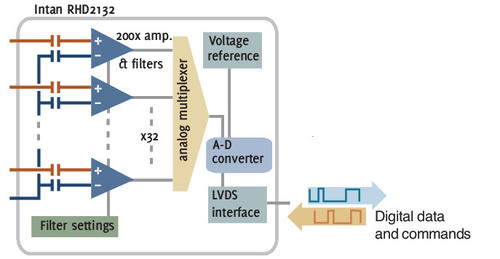There are a few different types of Open Ephys Headstages. All of them filter, amplify, digitize and multiplex data from the electrodes, and allow the data to be sent on to the rest of the acquisition system.
Headstages are distinguished by:
- The
- connector between them and the EIB (Omnetics or Hirose)
- Their shape (low-profile or standard-profile)
- Compatibility (the classic OE acquisition board, or next-generation system ONIX)
Open Ephys headstages use Intan amplifier chips to filter, amplify, and multiplex 32 channels of neural data. An analog-to-digital converter inside the chip digitizes each signal with 16-bit resolution. Instead of one wire per channel, as is required for analog headstages, our headstage can send 32 channels over a cable with only 12 wires. And As the signal is purely digital, so there are no tether artifacts.
Key figures:
30kHz sample rate, Lowpass 0.1-500Hz, HIghpass 100Hz-20kHz, 2.4uV RMS noise, 16bit resolution
The open ephys system is 100% compatible with commercially available Intan headstages.
Currently all of our Omnetics-based headstages follow the same reference/ground pin standard as Plexon, Blackrock, and TBSI headstages, though the ordering of the data channels is different. See channel mapping page for details.TODO: link to SPI and tether standards
Currently documented headstage designs:
| Child pages (Children Display) |
|---|
